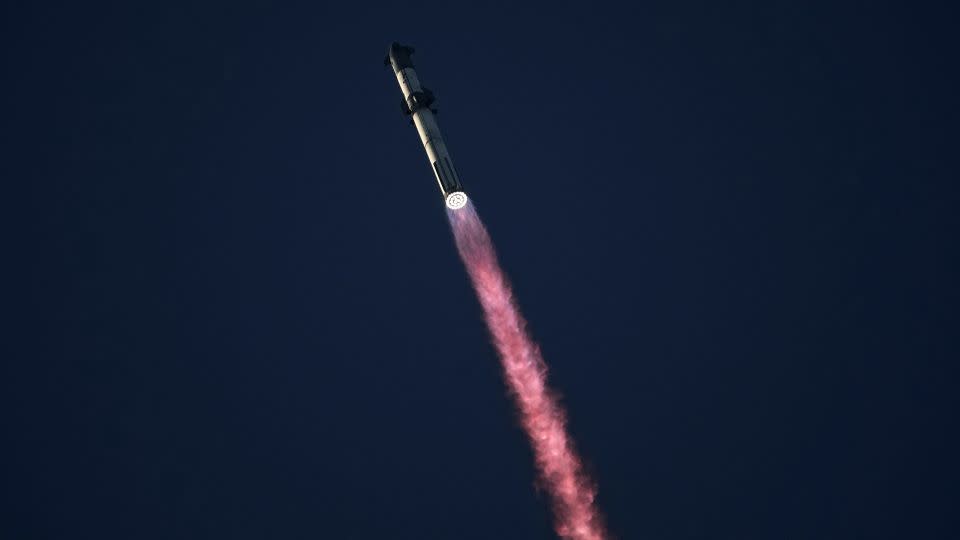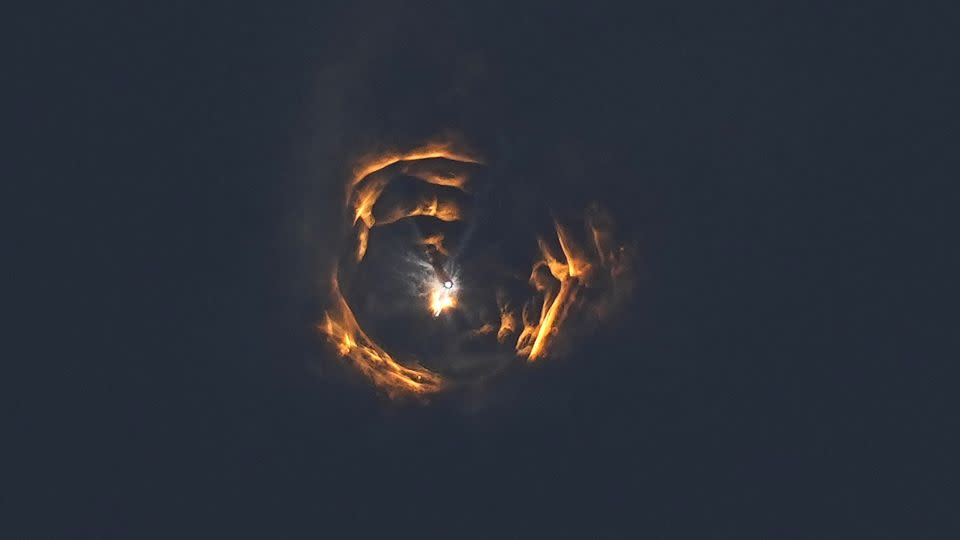The most powerful rocket ever built just went farther than it had ever gone, then was lost

- Oops!Something went wrong.Please try again later.
Sign up for CNN’s Wonder Theory science newsletter. Explore the universe with news on fascinating discoveries, scientific advancements and more.
SpaceX’s gargantuan deep-space rocket system, Starship, safely lifted off Saturday morning but ended prematurely with an explosion and a loss of signal.
The Super Heavy booster and Starship spacecraft successfully separated after liftoff, as the Starship lit up its engines and pushed away. That process ended up destroying the Super Heavy booster, which erupted into a ball of flames over the Gulf of Mexico. But the Starship spacecraft was able to briefly continue its journey.
The Starship system made it much farther into flight than the first attempt in April. The rocket and spacecraft lifted off the launchpad at 8 a.m. ET, with the Super Heavy booster igniting all 33 of its Raptor engines. Even during ground tests, SpaceX has had a hard time getting all of those engines, clustered together at the base of the rocket, to power on consistently at the same time.
The Starship upper stage had begun its trip Saturday morning strapped to the top of the Super Heavy first stage, a 232-foot-tall (70.7-meter-tall) rocket. About two and a half minutes after roaring to life and vaulting off the launchpad, the Super Heavy booster expended most of its fuel, and the Starship spacecraft fired its own engines and broke away.
The Starship spacecraft used its own six engines to continue propelling itself to faster speeds. SpaceX aimed to send the spacecraft to near orbital velocities, typically around 17,500 miles per hour (28,000 kilometers per hour). Starship climbed to an altitude of about 93 miles (150 kilometers) above the Earth’s surface, reaching the edge of space.
The US government considers 50 miles (80 kilometers) above Earth’s surface the edge of outer space. Internationally, the Kármán line, located 62 miles (100 kilometers) above sea level, is often used to mark the boundary between our planet and space — but there’s a lot of gray area.

The SpaceX team awaited acquisition of signal from the spacecraft, but shared during the livestream that the “second stage was lost.”
“The automated flight termination system on second stage appears to have triggered very late in the burn as we were headed down range out over the Gulf of Mexico,” aerospace engineer John Insprucker said.
The flight termination system is essentially a self-destruct feature that SpaceX engaged to prevent the Starship from traveling off course.
“The booster experienced a rapid unscheduled disassembly shortly after stage separation while Starship’s engines fired for several minutes on its way to space,” SpaceX shared on X, formerly known as Twitter. “With a test like this, success comes from what we learn, and today’s test will help us improve Starship’s reliability as SpaceX seeks to make life multiplanetary.”
The Federal Aviation Administration, which licensed the Starship’s test flight today, issued a statement after the test flight.
“A mishap occurred during the SpaceX Starship OFT-2 launch from Boca Chica, Texas, on Saturday, Nov. 18. The anomaly resulted in a loss of the vehicle. No injuries or public property damage have been reported,” according to an FAA spokesperson.
The agency will conduct a mishap investigation to determine the root cause of the loss of Starship, which is standard procedure.
“A return to flight of the Starship Super Heavy vehicle is based on the FAA determining that any system, process, or procedure related to the mishap does not affect public safety,” according to the FAA.
It took more than four months for the FAA to complete the last mishap investigation after Starship’s test flight in April.

Starship goals
NASA is investing up to $4 billion in the rocket system with the goal of using the Starship capsule to ferry astronauts to the lunar surface for its Artemis III mission, currently slated to take off as soon as 2025.
The endeavor is aiming to return humans to the moon for the first time in five decades, and the successful completion of this test flight would have brought the US space agency and SpaceX one step closer to that goal.
“Congrats to the teams who made progress on today’s flight test,” NASA Administrator Bill Nelson shared on X. “Spaceflight is a bold adventure demanding a can-do spirit and daring innovation. Today’s test is an opportunity to learn — then fly again. Together @NASA and @SpaceX will return humanity to the Moon, Mars & beyond.”
“Each test represents a step closer to putting the first woman on the Moon with the #Artemis III Starship human landing system. Looking forward to seeing what can be learned from this test that moves us closer to the next milestone,” Jim Free, NASA associate administrator for exploration systems development, shared on X.
The failure could spell significant delays for Starship’s development and the key missions lined up on its manifest, most notably NASA’s Artemis III mission. The US space agency tapped Starship in 2021 to serve as the lunar lander for that mission.
‘Hot staging’ process
The root cause of the Starship rocket’s failure on Saturday was not immediately clear.
But the booster explosion occurred after a phase called “hot staging” that SpaceX tried for the first time Saturday.
The method was used to separate the Starship spacecraft and Super Heavy rocket after liftoff.
Almost all rockets go through a process during launch called “stage separation,” in which the bottommost rocket booster diverges from the rest of the rocket or spacecraft.
When SpaceX launches its workhorse Falcon 9 rocket, for example, the first-stage booster — or the bottommost portion of the rocket — breaks away from the upper part of the rocket less than three minutes into flight. The Falcon 9 does so using pneumatic pushers that are housed within the rocket’s interstage, or black band around the center.
Instead, the Starship spacecraft fired up its own engines to push itself away from the Super Heavy booster — and it’s essentially separation by blunt force trauma.
It marked a crucial moment for SpaceX, as hot staging was expected to be “the riskiest part of the flight,” SpaceX CEO Elon Musk said in October.
SpaceX had already said it would consider the mission a success if Starship made it past hot staging.
But after hot staging, the Super Heavy booster began tumbling out of control and exploded over the Gulf of Mexico just moments later. SpaceX had hoped to reignite the Super Heavy’s engines and guide it to a controlled landing.
“We did know that hot staging was going to be incredibly dynamic,” said Kate Tice, senior manager of SpaceX Quality Systems Engineering, during the livestream. We knew that there was a chance that the booster would not survive, but we’re going to take that data and figure out how we can make the booster better for the next hot stage.”
Initially, the Starship spacecraft continued moving along after separation.
About eight minutes after liftoff, cheers could be heard echoing throughout mission control as the Starship was approaching the end of its engine burn — putting it on a path toward Earth’s orbit. But nine minutes after launch, SpaceX made it clear that it lost video signal with Starship.
And about 11.5 minutes into the flight, the company confirmed it had lost data, indicating Starship wasn’t flying as planned. Then, the spacecraft’s flight termination system was triggered to prevent it from veering off course, bringing an early end to the test flight.
If all had gone according to plan, Starship would have continued accelerating toward space. The Starship spacecraft was then slated to complete nearly one full lap of Earth, aiming to splash down in the Pacific Ocean near Hawaii.
The destruction of the vehicle shortly after liftoff was reminiscent of the Starship’s first launch attempt in April. During that test flight, several of the Super Heavy’s engines unexpectedly powered off and the rocket began spiraling out of control just minutes after liftoff. SpaceX was forced to trigger the system’s self-destruct feature, blowing up both stages over the Gulf of Mexico.
SpaceX took several months to recover from the April mishap. The company was forced to rebuild its launch site, which had been torn to pieces by the sheer force of the rocket powering its engines. The company also implemented upgrades to both the Starship spacecraft and the Super Heavy booster.
SpaceX typically embraces fiery mishaps in the early stages of rocket development. The company has long maintained that it can learn how to build a better rocket more quickly and cheaply by flying — and occasionally exploding — early prototypes rather than relying solely on ground testing and computer modeling.
After April’s explosive first test flight, SpaceX noted “success comes from what we learn, and we learned a tremendous amount.”
For more CNN news and newsletters create an account at CNN.com

